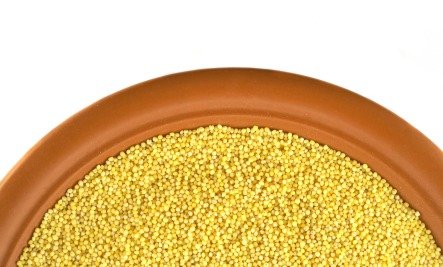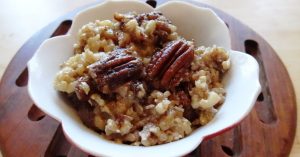Millet is a gluten-free grain that provides a host of nutrients and has a sweet nutty flavour. It is considered to be one of the most digestible and non-allergenic grains available. It is one of the few grains that is alkalizing to the body.
It has always been a favorite grain of mine since I discovered it in my hippy days in the 70’s!
Below, read about the 10 health benefits, some interesting trivia and history, 10 tips on how to use this gluten-free grain, and delicious recipes made from it.

10 Health Benefits of Millet
1. Millet is alkaline and it digests easily
Learn the10 Tips for Creating Alkaline Balance.
2. This grain is low on the glycemic index.
It will keep your blood sugar level stable. A study with diabetics showed that dehulled millet is beneficial for type-II diabetics.
3. Helpful for Digestion
This gluten-free grain acts as a prebiotic feeding microflora in your inner ecosystem. In a study, they found that there was prebiotic activity when eating millet, there was an increase in the friendly bacteria which helps promote digestion.
Best not eat too much millet at one time as there can be adverse side effects.
4. Useful in Preventing Cardiovascular Disease.
The consumption of this grain decreases triglycerides and C-reactive protein. Scientists in Seoul, South Korea concluded that millet may be useful in preventing cardiovascular disease. Nutrition Research. April 2010; 30(4):290-6.
5. All Millet Varieties Show High Antioxidant Activity
A team of biochemists analyzed the antioxidant activity; all varieties showed high antioxidant activity. – Journal of Agricultural and Food Chemistry, 9 June 2010; 58(11):6706-14.
6. Has a High Protein Content
It has more essential amino acids than most other cereals making it a substantial addition to a vegetarian diet.
7. Helps Lower Cholesterol
It contains soluble fiber, which traps fats and helps reduce cholesterol levels.
8. It is a gluten-free grain and non-allergenic
This makes it a great grain for gluten-sensitive individuals.
9. High in Calcium
Calcium is necessary for bone health, blood vessel and muscular contractions.
“It has the highest calcium content among all cereals (344 mg/100 g).” ~ Bharathiar University, Coimbatore, India
10. Helps with Good Sleep
The high levels of tryptophan in millet produces serotonin which is calming to your moods and helpful for sleep.
Please Note: Food and Safety tips: Millet is not an acid-forming food so it is easy to digest and is considered to be one of the least allergenic and most digestible grains available.
Millet contains small amounts of goitrogenic substances that limit the uptake of iodine to the thyroid. The “thyroid function inhibitors” can cause goiter when consumed in large quantities; this may explain the correlation between millet consumption and goiter incidence in developing countries where millet constitutes a significant part of the diet. Also, in some of these countries, there may be a lack of sufficient dietary iodine.

Nutritional information: 1 cup cooked millet
Calories 286
Carbohydrate (g) 57
Total fat (g) 2.4
Cholesterol (mg) 0
Saturated fat (g) 0.4
Sodium (mg) 5
Monounsaturated fat (g) 0.4
Thiamin (mg) 0.3
Polyunsaturated fat (g) 1.2
Niacin (mg) 3.2
Dietary fiber (g) 3.1
Magnesium (mg) 106
Protein (g) 8
Zinc (mg) 2.2
Data from Nutrition Data
There are Many Varieties
The main millets are:
- pearl
- foxtail
- finger (or ragi)
- proso (or white)
Other varieties are: Kodo, barnyard, little
Guinea, browntop, fonio and adlay (or Job’s tears)
Trivia Interesting facts:
- The Hunzas, who live in a remote area of the Himalayan foothills and are known for their excellent health and longevity, enjoy it as a staple in their diet.
- It was the main grain in China before rice.
- In North America and Europe, it has been grown primarily for animal fodder, pasture grass, and birdseed.
- The majority of the world’s commercial millet crop is produced by India, China, and Nigeria.
- It grows in stalks 1 to 10 feet high and ripens in 60 to 90 days.
- It will grow in relatively infertile areas, is drought resistant and matures in such a short time; great for growing in less agriculturally developed areas
- This grain ranks as the sixth most important grain in the world sustains 1/3 of the world’s population and is a significant part of the diet in northern China, Japan, Manchuria and various areas of the former Soviet Union, Africa, India, and Egypt.
- China, India, and Niger are the world’s largest growers of millet today.
History:
- The exact origin is not known but research says it was most likely cultivated simultaneously in Asia and Africa over 7000 years ago.
- It has been a staple in India and Africa for thousands of years.
- In the Old Testament, it is mentioned as a grain for making bread.
- Chinese archeologists found a 4000-year-old bowl containing long noodles made from millet.
- The earliest written record of millet, “Fan Shen Chih Shu” 2800 BC, gives detailed instructions for growing and storing the grain.
- There is even evidence that it was eaten and grown in the Stone Age in Switzerland.
- It first came to the U.S. in 1875, was consumed and grown by early settlers like corn, then fell into obscurity

How to Buy and Store:
- When purchasing from bins in the bulk section, make sure the bins are covered and that there is a good product turnover ensuring it is fresh. Also, make sure that there is no moisture.
- Store this gluten-free grain in an airtight container in a cool, dry and dark place; it will keep for several months.
- Best to buy Organic Hulled Millet.
10 Tips for eating or cooking:
- Instead of rice or potatoes, serve millet.
- Add it to your favorite chopped vegetables; make a stir fry.
- Add it to your salad; I like it warm.
- Make breakfast porridge with cooked millet; add your favorite nuts and fruits.
- Add it ground up to bread and muffin recipes.
- The Hunza’s use it as a cereal, in soups, and for making dense, whole grain bread.
- In India flat bread called roti are often made from millet flour.
- In Eastern Europe, millet is used in porridge and kasha or is fermented into a beverage.
- In Africa, it is used to make baby food, and as breakfast porridge.
- In some countries, it is used as a stuffing ingredient for cabbage rolls.
 What would life be like without gluten-free millet? Fortunately, it is readily available for me as it grows right here in my home province of Alberta. For those of you who thought that it was just bird food; it is one of the power foods for us.
What would life be like without gluten-free millet? Fortunately, it is readily available for me as it grows right here in my home province of Alberta. For those of you who thought that it was just bird food; it is one of the power foods for us.

Learn How to Cook Perfect Millet with my very simple energy-conserving way.
Delicious Gluten-Free Millet Recipes

Easy to Make Yummy Millet Pecan Pudding (Vegan and Sugar-free) – Once you have cooked it, this pudding is very simple to make. It is for sure tasty and so healthy without sugar so you can have it for breakfast. And it has no milk which makes it a great vegan dessert.
Millet Porridge – Vegan & Gluten-Free – This porridge is a great way to start the day. It is tasty, alkaline-forming, vegan and gluten-free!
Millet Pudding, Sugarless, Gluten-Free – This pudding is simple, very nourishing and is gluten-free and vegan too.
Millet and Buckwheat with Sunflower Seeds – This recipe is a favorite of mine; it is very yummy and mostly alkaline. The buckwheat with its full flavour enhances the very light flavour of the millet.
Tasty Millet Coconut Pudding with Brazil Nuts – This creamy coconut pudding is extra delicious with the addition of Brazil nuts. It is gluten-free, vegan and easy to make with all healthy ingredients.
100+ Superfoods
Learn more about some of the healthiest vegetarian foods you will always want to have in your pantry or growing on your deck.
READ: Superfoods – Over 100 of the Healthiest Foods You Should Have in Your Diet and learn more about the variety of Superfoods we think you should have in your diet.




Probably just a typo in the directions, but do you add the millet with the buckwheat or the sunflower seeds? Thanks! Sounds good, I’m going to try it.
Thank you Cyndi, I corrected the directions.
Hi Diana
This looks really good and I’d like to try it. But I’m allergic to Sunflower Seeds, what would you suggest for an substitute?
Carla, you can simply leave out the sunflower seeds and it will still taste great.
After you have done that; you could try pumpkin seeds and let us know how that works.
A friend used to add millet to whole wheat bread.
He would add the millet to the hot water which is added to the sponge after the first rising.
I don’t remember how much millet he would add per loaf (one loaf uses 3 cups flour)
He died a couple of years ago. If you can suggest how much millet to use, I would appreciate it.
Carolyn, I use 1/8 C ground millet and 1/8th cup plain. I mix it in with the dry ingredients (2.5 C whole wheat, 1/4 C cracked wheat, 1/4 C sunflower seeds, 1/4 C pumpkin seeds & 1/2 C wild rice).
Thank you Julian for your great list of ingredients for the bread.
Hi..I suppose then it would be a good substitute for bulgar wheat in the Middle Eastern salad tabouleh?
Melanie, yes millet is a great substitute for bulgar and more nutritious too.
In addition to all the above millet as not known by many, is used in eastern Uganda to make the best alcoholic nutritional beverage. research for that inform.
Hi Diana ,
It is surprising , how comes that a bird food can be cooked as a human food .I dont wish to beleive .. never . I apologize
To Ihsan: Corn, wheat, sesame and much else that humans eat are eaten by birds. Millet is bird seed, because, birds enjoy it. It is human food, because, humans enjoy it. It is healthy for both.
To Melanie: I have had very disappointing results with attempts to make millet-based recipes in the past, with trying to find millet for sale that is not stale, etc. The first really good experience I had, which was a few months ago, was when I was trying to make a tabuli for the first time, realized I had no bulgur, and remembered the millet I had bought from Sprout’s, a few months before, and decided to soak that and use it in the salad, instead.
It was really, really good. Which tells me that millet can be great tasting in the right recipe, can be a great substitute for other grains, and that Sprout’s is a pretty trustworthy place to buy grains from.
Thank you, Ma’am, for writing this lovely piece! I really learned some stuff.
You are welcome Arletta; always happy to hear about leaning happening here.
Thank you for your great replies above which you said very well! Sometimes I get so busy I do not see everything,
Thank you Arletta.
Ihsan.
I have some millet and was wondering if it could be used as a substitution for quinoa in a recipe that I have? What would the pluses and minuses be?
Thanks please I used to think its acidic .we have it in northern uganda but I do not know if it’s hear in Malaysia